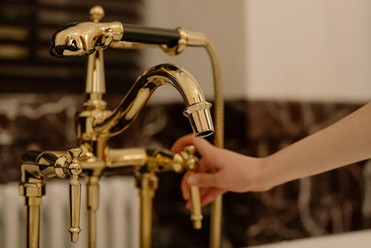How to use precious metals in architectural design, Sell gold coins NYC, New York City financial portfolio advice
How to Use Precious Metals into Architectural Design Advice
19 Jan 2023
Precious metals such as gold, silver, and platinum have long been valued for their beauty, rarity, and allure. These attributes have made them highly sought after throughout the ages for their use in making jewelry and other decorative items, as well as a store of value in the form of currency and commodities. The versatility in terms of color and finish makes precious metals ideal for adding aesthetic appeal, and depth to a space.
In addition to using gold to diversify your financial portfolio or silver to update your tableware, precious metals can also be incorporated into the architectural design of a building to enhance its visual interest and to add a sense of grandeur, luxury and timeless beauty. This article will explore the use of precious metals in the architectural design of your living space.
How to Incorporate Precious Metals into Your Architectural Design
Cladding
Precious metals can be used in cladding to help protect the external surfaces of a building from the elements while giving it an elegant and finished appearance. Metal sheets or panels made from gold, silver or copper can be added to external walls, roofs, and façades to add style and personality to a building as well as improve its insulation. You can achieve a lot with a 1 kilo gold bar melted and reformed into thin sheets of metal, or 1 kilo of silver transformed into lightweight sheets.Coating these metals with a protective finish will make them more resistant to weathering, corrosion and other environmental factors.
Precious metals can also be used in roof cladding through the use of metal shingles to add a modern and attractive look to your home while helping to improve its energy efficiency and long-term value.
Inlays and Accents
Another way to incorporate precious metals into the architectural design is through the use of metal inlays or accents to create ornate decorative features, geometric patterns or mosaics which add to the visual beauty of a building. Small pieces of precious metals such as gold or silver leaf can be embedded into surfaces such as walls, columns, archways, or entryways to highlight specific features or to add a distinct visual element to certain parts of a building. You can find out more about how to sell gold coins NYC at this site.
Fixtures and Fittings
One of the best ways to introduce a sense of opulence into your home is through the use of precious metal fixtures. Replacing your existing hardware through details such as fixtures and fittings can add a touch of elegance and glamor to a building. Gold-plated door handles, silver light fixtures or platinum faucets for your kitchen and bathroom can easily be incorporated into your home to add a beautiful finish and enhance the visual appeal of your interior.
Benefits of Precious Metals in Architectural Design
In addition to their visual appeal, precious metals can also offer many practical benefits in architectural design as listed below:
- Durability: Precious metals are well-suited for a wide range of architectural uses and are ideal for both interior and exterior use due to their resistance to corrosion and tarnishing. Their ability to withstand exposure to the elements without breaking down or deteriorating makes them an ideal choice for use in outdoor architectural applications, such as cladding and roofing and unlike other metals which can look dull and dingy over time, precious metals are more prone to maintain their shine and luster over time.
- Energy efficiency: Due to their high thermal conductivity, precious metals can be used to improve the energy efficiency of a building. Gold and silver are particularly effective at reducing the amount of heat absorbed by the building by reflecting sunlight, which can help to lower cooling costs and improve the overall energy efficiency of the building.
- Flexibility: Precious metals can be incorporated into the architectural design in a variety of different ways ranging from roofing and cladding to inlays and accents. This enables architects and designers to make the best use of these metals based on the building requirements and specifics of the project.
- Low maintenance: As they are resistant to weathering and corrosion, are durable, and have a long lifespan, precious metals are relatively easy to maintain compared to many other materials. This can help lower the costs associated with maintaining a building over time.
- Sense of status: Since ancient times precious metals have been regarded as symbols of wealth and luxury and their application in architectural design can make a building stand out and create a sense of status.
- Appreciation: As a use of currency, precious metals are globally regarded as a store of value, a safe haven asset, and a symbol of wealth. The use of precious metals in architectural design can help to increase the perceived value of a building, making it more appealing to prospective buyers or renters.
Precious metals can be an attractive and elegant addition to architectural design, adding a sense of luxury, grandeur, and visual appeal to a building. It is, however, important to consider the cost of incorporating these elements into your living space in addition to the benefits these materials can add to your architectural design.
Comments on this guide to How to use precious metals in architectural design article are welcome
Metal Design
Metal Posts
Most common metals used in architecture
Metal wall art: perks and things to consider
How To Choose an Architectural Metal Company
Building Articles
Contemporary Buildings – a recent selection from the e-architect website:
Design: Strom Architects
Ghyll House, East Sussex Property
Architects: BDP Glasgow studio + Allan Murray Architects
St James Quarter Edinburgh
Comments / photos for the How to use precious metals in architectural design advice page welcome





